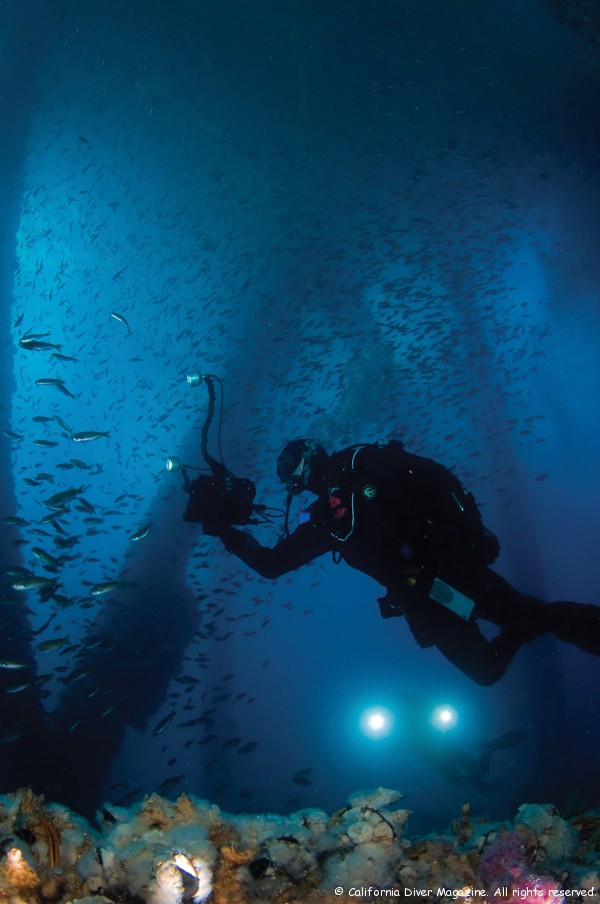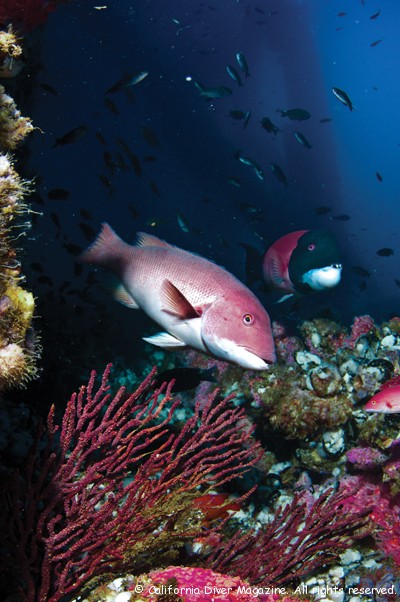California’s resources have brought both boom and bust in many locations throughout our golden state, and in the wake, there has always been something to be found. In the case of the once thriving oil industry, we have gigantic oil platforms. Built with pure brawn, steel and concrete to withstand the oceans unpredictable nature, these towering marvels of engineering have provided jobs for our economy, energy for our homes and now a manmade habitat for our sea life.
 First in California
First in California
California was the first place that offshore oil drilling was attempted in as early as 1896. The first derricks were built on piers along the coastline at Summerland near Santa Barbara. Unregulated drilling was conducted for decades, however further development was limited to the nearshore zone, using only the piers and a technique known as ‘slant drilling’. It wasn’t until 1956 that the first oil platforms were actually installed. Currently there are 27 operational rigs in California, 18 of which are constructed South of Santa Barbara.
Unfortunately since “nine-eleven”, most of these rigs have been closed to divers. The rigs in the Huntington Beach area remain open for diving, but access is limited. Rigs Eureka and Elly/Ellen, which is a double rig, are the platforms that are currently frequented by divers. These rigs are built in deep waters, and should be considered bottomless diving.
Diving the Rigs
The diving of oil rigs done by a live boat drop in open water near the platform. Diving these underwater marvels can get tricky, and advanced diving skills are needed to ensure safety in the open ocean. But for those adventurous souls that want a different experience, this is it. Depending on the time of year, the water temperature can vary from the low 50’s, and you may find more than one thermocline as you descend. Visibility is usually best in Fall, from October through December, unless heavy storms roll through. But due to the proximity to land, the visibility can be better here than most inland dive sites.

What makes the oil rigs a must-dive is the multi-dimensional reef system – it’s a truly unique experience, and environment. When I think of the oil rigs I can’t help but think of “the beauty and the beast”. From the surface, the beast appears as an intrusive ocean-going eyesore with its industrial appearance and labyrinth of catwalks, pipes and cables. The beauty part is what lies beneath. The vertical pylons extend from the sea floor and are joined together by interlocking crossbeams. Every inch, nook and cranny are covered with life. Layers of brittle stars, barnacles, anemones and corynactus, metridium, red and gold gorgonian adorn the pillars and beams. The interior of the structure is a vast open area, filled with the silver-black-silver movement of blacksmith. The scene is stunning, and fish are swaying in one direction then suddenly back again. When photographing the oil rigs and sea life that lives around the structures, I shoot continuously, trying to catch the movement.
A Fish Sanctuary
The oil rigs are now thought to be a sanctuary to the once depleted Boccaccio rockfish. In addition, there are several other types of rockfish that can be seen out here. Cabazon and giant sheephead wrasse, nudibranchs even barracuda and mola-molas have been seen.
Currently, some of these rigs are facing their own fate. Long-term leases are running out with no renewals, and in some cases the operational costs have exceeded their profitability. Once a rig is deemed non-operational, the owners have one year to plug the wells and completely remove the rig. This action is extremely controversial, as the methods for removal can be detrimental on the abundant sealife they support.
 The Rigs-to-Reefs program was created to participate in the conversion of some of these rigs into a more permanent solution. By removing and recycling portions of the rigs, the rest of the structure can be left intact to continue supporting the wildlife that now inhabit them.
The Rigs-to-Reefs program was created to participate in the conversion of some of these rigs into a more permanent solution. By removing and recycling portions of the rigs, the rest of the structure can be left intact to continue supporting the wildlife that now inhabit them.
Hopping a Boat
Diving the oil rigs is illegal without permission from the platform operators, and going with an experienced dive operation is much safer and reliable. The Sundiver (www.sundiver.net), based in Long Beach, is one boat I use which regularly takes divers to the rigs, and offers the convenience, experience and expertise needed for diving them. In this different underwater environment, that extra knowledge and experience can go a long way in making your dives not only safer, but more productive and enjoyable.
California’s oil rigs are in an open water habitat that is wild, beautiful and unique – true to California’s form. Be prepared when diving out there, always bring a signaling device, pay attention to the dive briefings, and stick to your dive plan. Due to the nature of the dives, newly certified divers are encouraged to become advanced divers through experience and certification before signing up for one of these trips.
California diving, there is no substitute!
Words and photos by Mike Bartick. Visit Mike’s website at SaltwaterPhoto.com.
